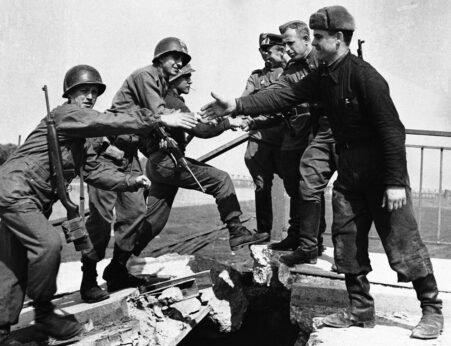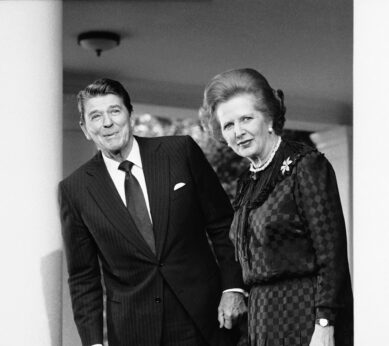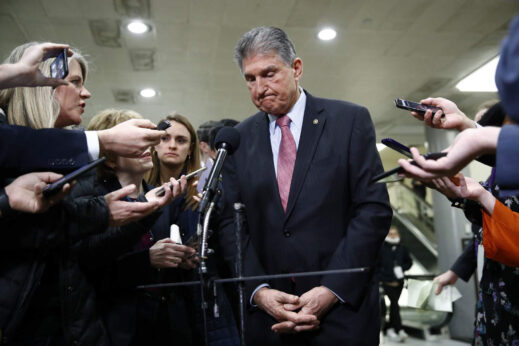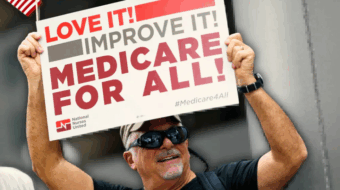
At the end of World War II, we saw a worldwide defeat of fascism. Millions in countries around the planet rejected what their fascist overlords had to offer—racism, genocide, economic austerity, and war. U.S. and Soviet soldiers marched for the same cause as they defeated fascism in one country after another.

The liberating troops marching into European capitals and overthrowing fascists were greeted by the masses in all those countries, and the new economic and political structures that replaced the old fascist regimes ranged from new socialist republics in Eastern Europe to social democracies in the West. Social safety nets of one degree or another were set up in all the formerly fascist countries, and they were established with broad popular support. In the U.S., there was broad popular support for FDR’s New Deal.
It would be difficult to argue that the defeat of fascism around the world in 1945 was not a victory backed by the masses of the people in all the countries involved, including Germany, Italy, France, and all the Eastern European countries, not to mention Japan, China, and all the liberated areas of the Soviet Union.
Since then, something triggered the unraveling of those victories. Since the 1980s, we have seen neo-fascist movements grow and even gain the upper hand in countries like Hungary, Poland, Italy, the Philippines, Brazil, in some former Soviet republics, and, at least during the Trump years, in the United States.
The far right resurgence goes way back to the 1980s and was given a powerful shot in the arm in the 1990s. That boost came in the wake of the defeat of the socialist countries in Europe. New forms of fascism sprung up almost overnight, it seemed, right after the demise of socialism in Eastern Europe.
This neo-fascistic development had different characteristics and took shape in different ways in the various countries where it occurred. Such was the case with the classical fascist movements that developed and held sway in Europe from 1920 until 1945. There was no monolithic form of fascism back then, just as there is no monolithic form of neo-fascism today.
Another similarity between fascism back then and now is that there is no set of cultural, religious, or political “traditions” that immunize any particular country against fascism. It can and does happen anywhere. Contrary to belief in some circles, Germans were not better attuned to fascism than Italians. People of both nationalities made excellent and efficient fascists. The preconditions for fascism can and do develop everywhere, and once they are in place fascism thrives—at least until it destroys everything upon which its existence depends.
Important examples of the preconditions required for fascism are the spread of irrational ideas, racist viewpoints, and hatred of and impatience with democratic procedures. Once these ideas reach a critical mass, the path for the development of neo-fascism is much easier.
Very important for the neo-fascists is the fostering and nurturing of these ideas among leaders respected by people. It’s a key first step toward getting masses of people prepared to accept fascist rule. Broad majority support for fascist ideas is not the prerequisite needed for actual takeover by or rule by fascists.
In Nazi Germany, the fascists targeted well-respected leaders in all sectors—health, education, labor, city planning, transportation, elected lawmakers. If they could win the backing of key segments of these groups, it would be far less likely, they understood, that the people as a whole would rebel against them.
No mass support
There was no mass support, for example, for the establishment of concentration camps. Once established, however, they were an excellent means of guaranteeing compliance with fascist rules.

Fast forward to modern times—by the late 1970s and early 1980s, capitalism was experiencing sharp problems of stagnation in its growth potential and a reduced ability to deal with social problems. The solution devised by the ruling class was the neoliberal approach of ending regulation and introducing austerity—a solution reflected in the politics of right-wing leaders like Ronald Reagan in the U.S. and Margaret Thatcher in the U.K.
There were calls to “reform” the market economy by turning it loose and by curbing democratic developments like regulations on finance and institutions like Social Security and labor unions. Successful public programs were gutted and privatized. “Freedom” was the word used to cover the robbery of the people and lining the pockets of the rich with the spoils.
This ideology was put forward by popular leaders like Reagan who, as the result of clever propaganda and imagery, was respected by much of the public.
After World War II, the defeat of the Axis powers combined with the introduction of socialism in some places and a controlled form of capitalism allowing for social safety nets in others resulted in mass support for the transition away from fascist ideology.
It wasn’t until the 1980s really that we saw widespread revival of fascist-like ideologies and movements. It is no accident that this revival paralleled closely the rise of the neoliberal economic and social policies reflected in Reaganism and Thatcherism. The deregulation that was ushered in destabilized the lives of millions around the world, pushing more and more people into poverty as they lost what tiny bit of stability they had wrested from the capitalist system after World War II.
In the U.S., this destabilization, stagnation, and worsening of livelihoods for the majority provided fertile ground for other harmful ideologies, such as religious fundamentalism. That religious fundamentalism worked hand-in-hand with neo-fascism to popularize a right-wing approach to solving the problems of society.
The comeback of fascism in various forms started not as full-fledged support for classical fascist policies but as support for popular leaders who espoused neoliberalism in response to the issues troubling people in the 1980s and ’90s. Unfortunately, even Democrats like Bill Clinton bought into and pushed the idea that “the days of big government are over.” The days that the neoliberals saw as “over” were the days when government worked for the people.
The collapse of socialism and the replacement of progressive ideas with Reaganism in the U.S. and allied leaders in Europe caused sharp increases in unemployment and the weakening or destruction of safety nets everywhere.
Urban neighborhoods experienced deterioration as poverty and crime both started to increase. How many Americans today lament about how the cities they came from were so “great” in the 1980s or ’90s but are a “mess” now?
Adding to the problems caused by neoliberalism was the massive dislocation of entire populations all around the world, the result of intensified capitalist exploitation. Immigrants to the developed countries were used as cheap labor, driving down the working conditions of the working-class populations of those developed countries. Anti-immigrant racism added to the support for various forms of neo-fascism.
The neoliberal counter-revolution
The neoliberal push was the underlying trigger to today’s neo-fascist revival. The Reaganite push was for deregulation, privatization, slashed social spending, and tax cuts for the rich. In the U.S. case, religious fundamentalism was an ideology that conveniently fit with right-wing neoliberalism and bolstered neo-fascism. It is, in fact, an American characteristic of the neo-fascism we are dealing with now.
When a whole country applies neoliberal approaches to its economy, the inevitable result is severe economic dislocation marked by recessions during which we see mass suffering for everyone but the rich. We see this happening today, but it is not the COVID pandemic alone that is to blame. The Great Recession of 2007 showed that we didn’t need a pandemic to wallop the economy. When such recessions occur, the path taken by the ruling class is one that requires the working-class majority to bail them out of the mess they created. This opens the door further to even more neo-fascist ideas taking hold.
Democracy is responsible for the mess, people are led to believe. It’s not capitalism, deregulation, or austerity that causes the problem, it is too much democracy, we are told. Democratic processes are portrayed as inefficient, dysfunctional, and vulnerable to corruption and manipulation.
At the end of World War II, it was clear to millions in Europe and America that fascism was the cause of the misery and war that had been foisted by capitalists upon the planet and its people. They were unlikely to support any form of fascism at that time, and in fact, massive propaganda efforts had to be mounted in order to get people to blame communists rather than capitalists for their problems.
Today we do not have, as we did after World War II, such a high level of anti-fascist consciousness. True, a massive coalition formed and successfully ousted Trump, but it is not a coalition that understands yet that we are in a battle against neo-fascism and that the modern day fascists stand ready to take over even more overtly than they did during the Trump years.
We are going to have to defeat ideologically all the policies and ideas that lay the groundwork for acceptance of neo-fascistic solutions. Racism and anti-communism, of course, are at the top of the list.
Politicians who don’t take on these twin evils are wittingly or unwittingly helping accelerate the advance of neo-fascist politicians and their ideas.
Propaganda about the allegedly innate efficiency of the market economy also has to be challenged. Politicians must fight even the suggestion that health care for all is deliverable by private corporations. Opposition to single payer health insurance is more than just advocating a less radical approach to health care. It helps lay the groundwork for neo-fascism because it perpetuates a system where millions end up with no health care. That situation benefits neo-fascists who will claim that “democracy” is unable to deliver people programs that meet their basic needs.
Politicians who today call for less expensive rescue plans for our economy are making their own contribution to laying the groundwork for neo-fascists. A rescue plan that is too small will fail, giving the neo-fascists fodder to use in the next round of elections.
Neoliberal calls for “balanced budgets” at a time when the rich have secured for themselves massive tax cuts also play into the hands of the neo-fascists.
“Bi-partisanship” a cover
In short, support for any and all of the failed neoliberal approaches to solving our economic problems, even when done in the name of “bipartisanship,” all lay the groundwork for the growth of the dangerous neo-fascist movements in this country and around the world.

Even if unwittingly, any politician who backs a neoliberal approach to solving the problems of today is supporting the rise of neo-fascism. The fascist regimes in Brazil, Poland, Hungary, India, and the Trump regime in the United States were the direct end product of neoliberalism over the last few decades.
The defeat of Trump in the 2020 election was a significant victory for the people. It is a defeat to be widely celebrated, but it is not a victory nearly on a scale as grand as the defeat of fascism in 1945. Trump was defeated because a powerful coalition was able to garner 82 million voters to oust him from the White House.
Unlike the fascists in World War II, however, he was not defeated because masses of people once in support of fascists deserted them. The numbers of Trump supporters actually increased by 11 million from the prior election to 74 million this time around.
Particularly disturbing about Trump’s numbers is that this time, unlike 2016, there were not millions who one could say really did not understand what he was all about. After four years, it was clear to people voting for him what they were voting for.
And the support for the new fascists continues overseas, too, with strong backing for Bolsonaro in Brazil, Modi in India, and Orban in Hungary. Brazilians, Hungarians, and Indians backing these people know what the leaders they are backing are all about.
Achieving a victory over the neo-fascists we see around the world does require a defeat at the ballot box, as we have done here in the U.S. But it will also require a defeat of poisonous ideologies, chief among which are racism and anti-communism.
Very important and absolutely essential is to reject in their entirety the neoliberal ideas that began spreading like a cancer ever since the Reagan years. Right-wing Republicans like Mitt Romney who support tax cuts for the rich and oppose a rescue plan for the people are not our friends simply because they cast a vote against Donald Trump’s crimes. Nor are Democrats like Joe Manchin who go along with neoliberalism rather than a program for the people that raises wages and strengthens social policy.
Neoliberalism in all its stripes is dangerous. It’s the reason we face the threat of neo-fascism today.










